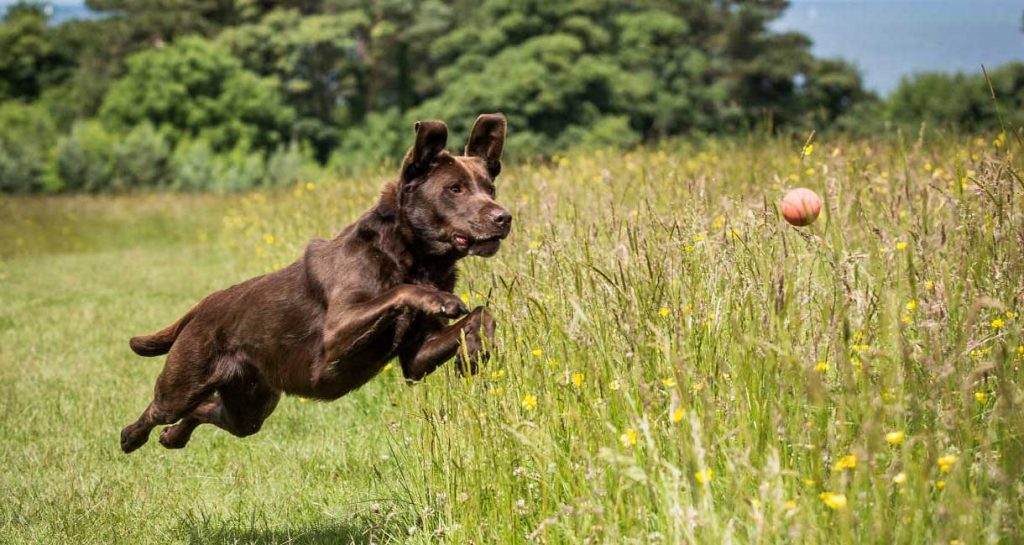Labradors are famously known for their high levels of intelligence and energy. These even-tempered dogs have a well-balanced conformation that needs to be maintained with various kinds of physical activities. Otherwise, your dog can develop conditions like obesity and related complications. Besides that, your Lab’s mental health can also be affected. It can start indulging in some highly destructive and undesirable behaviors that are neither good for you nor for your dog.
Some of the most common questions that are asked by Labrador owners are:
- Exactly how much exercise their Lab needs to stay fit?
- How do they know that their Labrador is exercising enough or not?
- What kind of exercises should their Lab do?
- Is walking enough?
- How much of walking is required to reap the benefits?
Pore over to find out the answer to all these questions.
Why Are Labrador Retrievers So Energetic?
Labradors were initially used as retrievers of ducks and fishes from the North Atlantic’s frosty waters. Later they were taken by English nobles to England to retrieve birds during hunting trips. Since the hunting grounds often comprised of water bodies and marshy lands, Labradors had to frequently run, swim and hike to retrieve hunted birds. Such activities required a lot of energy. And therefore, Labrador Retrievers had turned out to be very active in nature.
These days, Labradors are considered one of the best family dogs because of their social and loyal nature. However, their status as a family dog has not affected their genetics. They continue to be very energetic dogs and therefore require a lot of exercises.
What can happen if you do not work out your Lab enough?
As mentioned earlier, Labradors, by nature, are very active dogs. So, if you do not exercise your Lab enough, it will start suffering from boredom and frustration. Consequently, it will begin indulging in all kinds of destructive behaviors, such as chewing and digging. Besides that, it will develop a terrible habit of barking and try to sneak out of your home whenever possible.
People often complain about their Labrador’s rebellious streak. But they fail to understand that Labradors are not by nature rebel. They involve in such activities only when they are frustrated. Otherwise, how will they release their pent up energy? Therefore, it is imperative to engage your Labrador in various outdoor activities and exercises.
Apart from their mental health, lack of exercise can also affect your Lab’s physical health. Since Labradors are obsessed with food, they are more prone to develop conditions like obesity than any other breed. And once they become overweight, their body will become the breeding ground for all forms of diseases. Some of those diseases include:
- Joint Issues (elbows and hips)
- High Blood Pressure
- Diabetes
- Heart problems
So, if you want to keep your Labrador away from all kinds of physical and mental problems, make sure you exercise your dog enough.
What are the Signs to Identify that your Labrador Needs to Exercise more?
Even though your Lab cannot talk like you to express its internal problems, its behavior and body language are enough to alert you to its exercise needs. Some of the significant signs that your Labrador is not receiving enough exercise are:
- Running around the house like a whirlwind.
- Not listening to commands that you have taught them to follow.
- Indulging in undesirable behaviors like biting, digging, and chewing.
- Getting tired after performing simple tasks like mounting the stairs.
- Gaining a lot of weight even when you don’t let them eat too much.
If your Labrador exhibits any of the symptoms mentioned above, it is time to get yourself mentally prepared and engage your dog in an all-around fitness regime.
Different Benefits of Exercising
Engaging your Labrador in a proper fitness regimen can help your dog reap physical as well as mental benefits.
Physical Benefits of Exercising
- Healthier lungs and heart for better circulation of oxygen and blood.
- Proper regulation of body temperature.
- More durable and flexible joints and bones.
- Creation of more RBCs (red blood cells) for an adequate oxygen circulation.
Psychological Benefits of Exercising
- Improved mood.
- Less frustration
- No anxieties
- Not indulging in destructive behaviors like chewing and digging.
- Control over impulses.
Different Types of Exercises for your Labrador Retriever
To reap the benefits mentioned above, you need to indulge your Labrador in different kinds of exercises. Whatever outdoor activities you may choose, but do not go for a mere half an hour walk. Some breeds cannot be benefited from minor walking exercises. Labradors are one of them. Even though walking your Lab can develop a strong bond of friendship, it won’t do much for your dog’s cardiovascular system. If you want your dog to receive all the physical and psychological benefits of exercise, engage him in the following physical and mental activities.
Physical Exercises

Here is a list of some of the best physical exercises that will help your Labrador cast off its excess energy and make it fit, physically and mentally.
1) Swimming
Labradors were initially bred as fishermen’s mates. They were reared for searching and rescuing fishes and ducks from the North Atlantic’s icy waters. Therefore, their relationship with water is undoubtedly old.
With their water-resistant double coat and webbed feet, swimming comes almost naturally to them. And the best part is, most of the Labradors love water. Therefore, if you want to engage your dog in a high-intensity but fun-filled exercise, swimming is the best choice for your Lab.
It is low-impact and can produce the desired results in relatively less time. In fact, the results produced by 90 minutes of walking is equivalent to 15-20 minutes of swimming. And the most remarkable part is, your Lab’s excess energy will be cast out very effectively. Besides that, you can make the experience much more thrilling by playing fetch with your dog in the water.
However, make sure that your Labrador wears a life jacket when it steps into the water. Even though Labradors are able swimmers, but you never know the water currents. Dangers can lurk anywhere. And your goal is to make this whole exercise not only impactful but also safe.
2) Cycling or Jogging
Walking may not be the exercise for Labradors, but running certainly is. Cycling or Jogging with your dog can certainly be helpful for its cardiovascular system. With their muscular and well-balanced conformation, Labradors have, in fact, been built for sprints and long runs.
However, before engaging your Lab in running exercises, you need to make sure it is comfortable with the pace. Do not indulge your dog in this regime if it is too young or too old. Otherwise, your Labrador’s joints may get affected, and it may develop conditions like hip and elbow dysplasia.
If your Labrador is healthy enough to start this regime, then start with simple walking. Once your dog gets bored with the pace, start increasing the speed. Your Lab will definitely love this exercise.
3) Fetching Games
As we all know, Labradors have been bred to retrieve things. Consequently, when they are engaged in some kind of retrieving games, they participate with a distinct level of rigor and energy. Therefore, if you wish to engage your dog in some pressing cardiovascular exercises, make them play fetch.
With their innate love for retrieving, Labradors will go to any length to fetch the item you have thrown. Consequently, you won’t have to invest much time in this game. A mere 20-30 minutes for three to four days a week will be more than enough for your Lab’s physical fitness.
If you wish to intensify your dog’s experience, throw the item as far as you can. Some toys can help you make this game an even more effective source of workout for your dog.
4) Hiking
If you love to go on hiking trips, consider Labradors as one of your best companions. With their strength, stamina, and agility, they are almost natural with hiking. And the best part is, it can be a highly useful source of workout for your dog. It will not only benefit their cardiovascular system but also give them a thrilling experience. Consequently, you won’t have to worry about keeping them in shape.
However, do consult a vet to verify your dog’s overall health before going for such trips. And don’t forget to take all the necessary precautions before you plan to take your Lab for hiking. Remember that you have to make this experience thrilling as well as safe for both of you.
5) Retriever Training
Labradors are, by nature, retrievers. So why not engage them in an exercise for which they have been incipiently made? Making your dog participate in Retriever Training programs can prove to be one of the best sources of workout. It will not only benefit your Lab physically but also mentally.
A small session of 20 to 30 minutes comprises of several short and long retrieves. As a result, your Labrador has to engage in both short and long sprints. With such intensity, your dog’s cardiovascular system is bound to be benefited.
Besides that, your dog’s mental tenacity is also tested, as retrieving requires a lot of self-control and patience.
6) Chuckit!
It is a very convenient toy to play “fetch” with your Labrador. One of the many advantages of this toy is that you can throw it as far as possible. And each time you throw it, your dog has to run at least 18 meters further to fetch it. Therefore, if you play this game with your Lab for at least 20 minutes, you will definitely find a difference in your dog’s physical health.
Besides that, you can use this toy anywhere you want. Just make sure that the location is spacious enough to throw the toy as far as you can. Also, you don’t need to do the dirty work of holding a saliva covered toy. Your Lab will fetch the toy using its handle, and you can use the ball part to throw it again.
7) Jolly Jumper
It is a kind of ball with many knobs and bumps all over its body. Whenever it hits the ground, it makes unpredictable movements. Being inquisitive, Labradors love “Jolly Jumper.” Its erratic movements trigger their curiosity. Besides that, when you attach a treat to this ball, that is a cherry on the top-like situation for your Lab.
Consequently, each time you throw this ball, your dog will use its full potential to grab it. And because the ball makes too many unpredictable movements, your Labrador has to run a lot to fetch it for you. As a result, your Lab’s heart will be pumped up enough to shed its excess energy.
Furthermore, the ball glows when it hits the ground. Therefore, you can play with it at night as well. Just make sure that the area is spacious enough and without any obstacles. Otherwise, your Labrador will hurt itself while chasing its glowing toy.
8) Recall Game
You can call it your Labrador’s version of the baseball game called “Hotbox.” You can play this game with your whole family. Just get some treats for your dog and some whistles. Give one pipe, and some dog treats to each of your family members and spread out for approximately 10 meters.
Call your Lab by blowing your whistle. Once it reaches you, give it some treat and ask your partner to blow his whistle. In this way, you can make your Lab sprint back and forth and keep spreading out to increase the game’s intensity. If the treats are finished, just rush in a different direction to keep your Labrador engaged.
Such a high-intensity game will surely benefit your Labrador’s cardiovascular health. And you won’t need to invest much time to exercise your dog.
Mental Exercises

Labradors are ultimately retrievers. A task that requires both intelligence and agility. How will they survive if their mental abilities are not adequately utilized? Hence, it is vital to provide them with some mind-engaging exercises as well. Given below is a list of some of the best mental activities for your Labrador:
1) Toys for Stimulating your Lab’s Mind
Not all playthings are for fetching. Some are for triggering your Labrador’s mind as well. And the best part of such toys is that you don’t need to invest any time behind your dog. If you are busy with some work, just give those toys to your Lab and concentrate on your work without any tension.
Some of the notable examples of such interactive toys are:
- Kong Jump’N Jack
- Starmark Fire Plug
- Kong Classic
Just fill these toys with some fresh dog treats and toss it outside your house. Your Lab will make the optimum use of its brain to take those treats out of the toy. And the best part is, your Lab can work for hours on those toys without getting bored. However, to remain on the safe side, it is better to keep changing your dog’s toys.
2) Hide and Seek
We all love to play, hide, and seek. And why not? It engages our body and mind so much. The same is the case for your dog. Being retrievers, your Lab will love to play this game of searching and rescuing. And once your dog gets accustomed to this game, you can keep him engaged for hours.
Just get some dog treats for your dog and throw it somewhere in your room or garden. Call your dog and try to drive its attention to the doggy treat. Make sure the food is delicious enough to engage your Lab’s interest. Once you are successful, stuff the dog treats in a toy and again throw it on the floor. Once your Lab goes towards the toy, give the command “Find it.” Do this whole process all over again.
Now, hide the toy somewhere and command your Lab to find it. As your dog gets more accustomed to this game, you can hide the toy in more hard to find locations and sharpen your Lab’s retrieving qualities.
3) Obedience Training
It is one of the most elementary forms of mental exercises that you can use to stimulate your dog’s mind. It is also necessary to make your dog follow your commands. Make some time from your busy schedule and start teaching your Labrador the words that you intend to use to address it.
Begin with the basic commands like stay, sit, come, go, and leave it. Be consistent with the instructions and repeat them for a useful learning experience. Your Labrador can learn up to 200 words. So make the most of it.
4) Socialization Training
It is another important form of mental stimulation that you must provide your dog. Expose your Labrador to a wide range of people. Allow it to feel the smell of different types of human beings. Let it interact and play with other dogs and puppies. It will make your dog social and allow it to have a lot of physical exercises.
Take your Lab to new places and environments. It will teach your dog to deal with different situations. Consequently, your Labrador will be less prone to suffer from conditions like anxiety.
Do Not Over-exercise your Labrador
While under-exercise can lead your Labrador to suffer from various physical and mental problems, Over-exercise can lead them to get tired and subsequently collapse. And you definitely don’t want that. So, try to keep a balance and do not exercise your Labrador under the following conditions:
- When your Lab is injured or sick: Exercising your dog during sickness or injury will lead to more damage than good. It is better to let your Lab have an ample amount of rest to recover fast and become rejuvenated enough to go for long runs.
- When your Labrador has become overweight: People often make the mistake of thinking that they can reduce their dogs’ weight by engaging them in intense workouts. However, the reality is that your dog will not be willing to lift even a leg if it becomes overweight. Moreover, working out an overweight dog for hours can cause a lot of damage to its joints. Therefore, what you need to do is monitor your Lab’s eating habits first. Reduce its calorie intake and make it lose some weight. Once you are successful, you can exercise your Lab as much as you want.
- When your Labrador has become too old: Just like human beings, the bones and joints of dogs become weak when they grow old. Consequently, they may find it hard to indulge in high-intensity exercises. Some dogs even find it difficult to walk. Therefore, it is better to let your old Lab rest and strictly focus on its eating habits to keep it in shape.
Consult a Vet
Consult a vet before starting an exercise regime for your Labrador. Remember that not all Labradors are the same. Therefore, not all exercises will suit your dog. To select the most suitable set of workouts for your Lab, you need to get its height, weight, and all other parameters checked. And it can be practicable only when you approach a vet. After verifying your dog’s overall health, your vet will decide whether you can start a particular type of fitness regime or not.
Conclusion
As far as your Labrador’s exercising needs are concerned, it all depends on their health, age, and heredity. If your Labrador is involved in sports and field trials, it will need more exercise. Conversely, if your Labrador is for show or conformation, it will require less workout.
A 12 weeks old Lab puppy’s exercise needs a very limited. In fact, they get tired of mere dog games. So, do not push them to exercise unless they have reached the age of 12 weeks old. Otherwise, your pup can develop various kinds of joint issues when they grow up. After 12 weeks, start exercising them for 5 minutes unless they reach the age of 1 year. After that, with the consultation of a vet, start a full-fledged exercise regime.
As far as adult Labradors are concerned, their exercise needs will depend on their overall health and intensity. Get your dog checked by a vet and cater to their exercise needs accordingly.
Generally, a healthy, adult Labrador needs half an hour of intense exercise for no less than three times a week. On the remaining days, indulge your Lab in less intense workouts for 45 minutes to one hour.
References
- https://academic.oup.com/jn/article-abstract/136/7/2050S/4664835
- https://link.springer.com/content/pdf/10.1007/s00360-009-0367-z.pdf
Table of Contents





